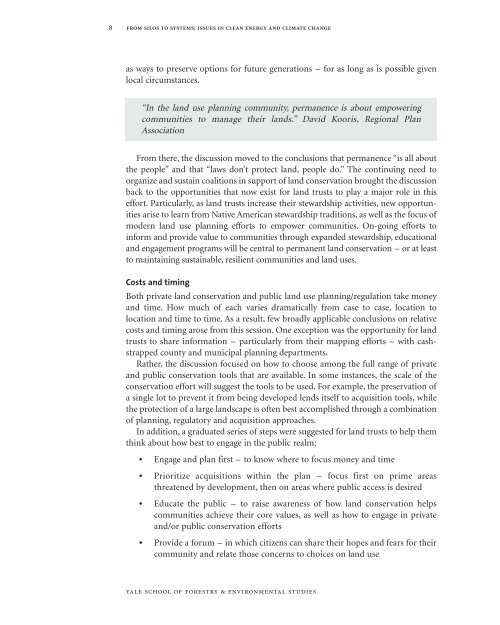Complete Report - Yale University
Complete Report - Yale University
Complete Report - Yale University
You also want an ePaper? Increase the reach of your titles
YUMPU automatically turns print PDFs into web optimized ePapers that Google loves.
8FROM SILOS TO SYSTEMS: ISSUES IN CLEAN ENERGY AND CLIMATE CHANGEas ways to preserve options for future generations – for as long as is possible givenlocal circumstances.“In the land use planning community, permanence is about empoweringcommunities to manage their lands.” David Kooris, Regional PlanAssociationFrom there, the discussion moved to the conclusions that permanence “is all aboutthe people” and that “laws don’t protect land, people do.” The continuing need toorganize and sustain coalitions in support of land conservation brought the discussionback to the opportunities that now exist for land trusts to play a major role in thiseffort. Particularly, as land trusts increase their stewardship activities, new opportunitiesarise to learn from Native American stewardship traditions, as well as the focus ofmodern land use planning efforts to empower communities. On-going efforts toinform and provide value to communities through expanded stewardship, educationaland engagement programs will be central to permanent land conservation – or at leastto maintaining sustainable, resilient communities and land uses.Costs and timingBoth private land conservation and public land use planning/regulation take moneyand time. How much of each varies dramatically from case to case, location tolocation and time to time. As a result, few broadly applicable conclusions on relativecosts and timing arose from this session. One exception was the opportunity for landtrusts to share information – particularly from their mapping efforts – with cashstrappedcounty and municipal planning departments.Rather, the discussion focused on how to choose among the full range of privateand public conservation tools that are available. In some instances, the scale of theconservation effort will suggest the tools to be used. For example, the preservation ofa single lot to prevent it from being developed lends itself to acquisition tools, whilethe protection of a large landscape is often best accomplished through a combinationof planning, regulatory and acquisition approaches.In addition, a graduated series of steps were suggested for land trusts to help themthink about how best to engage in the public realm:●●●●Engage and plan first – to know where to focus money and timePrioritize acquisitions within the plan – focus first on prime areasthreatened by development, then on areas where public access is desiredEducate the public – to raise awareness of how land conservation helpscommunities achieve their core values, as well as how to engage in privateand/or public conservation effortsProvide a forum – in which citizens can share their hopes and fears for theircommunity and relate those concerns to choices on land useyale school of forestry & environmental studies
















